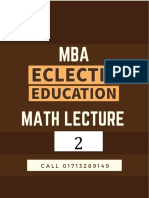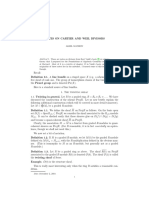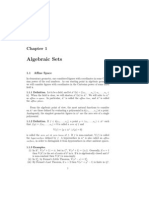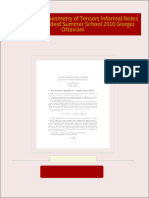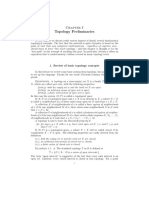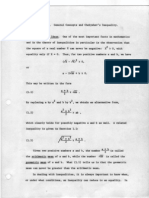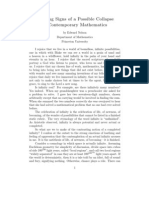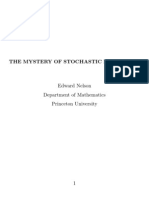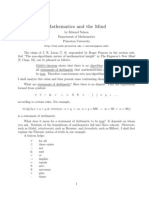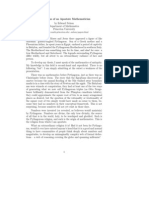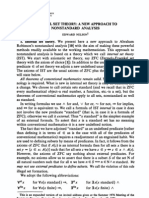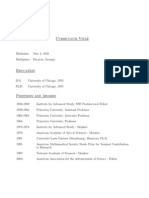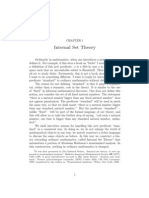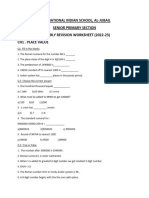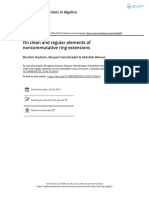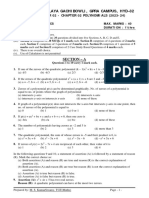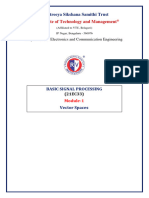July 26
July 26
Uploaded by
Epic WinCopyright:
Available Formats
July 26
July 26
Uploaded by
Epic WinCopyright
Available Formats
Share this document
Did you find this document useful?
Is this content inappropriate?
Copyright:
Available Formats
July 26
July 26
Uploaded by
Epic WinCopyright:
Available Formats
FINITE CATEGORIES: JULY 26
NOTES FOR THE REU
In the previous lecture, abstract simplicial complexes were introduced. Since they are essential to this lecture as well, the denition is repeated. Denition 1.1. An abstract simplicial complex K is a set of vertices V (K) and a set of nonempty subsets of V (K), called simplices, such that (1) Every vertex is in some simplex. (2) Every subset of a simplex is a simplex.. 1.1. Background on Topological Spaces. An earlier handout gives an overview of topological spaces, but a few concepts are reiterated here for review. The spaces about which we have the most intuition, and therefore think about the most, are Euclidean spaces n and subsets of Euclidean spaces. The Euclidean space n has a distance function d: n d(x, y) =
n
(xi yi )2 .
Then dene Ux, , the -ball centered at x, to be {y n : d(x, y) < }. The open sets of n are all the nite intersections and arbitrary unions of these sets for any choice of x and . The concept of a topological space generalizes Euclidean spaces: Denition 1.2. A topological space is a set X and a set U of subsets of X, called the open sets of X, such that and X are in U and nite intersections and arbitrary unions of elements of U are in U . This denition is much more general than Euclidean space. For example, an arbitrary topological space does not necessarily satisfy the following familiar separation property of n : for all distinct x, y X, there exist open sets U and V such that x U , y V , and U V = . A set function f : X Y from one topological space X to another Y may not take nearby points in X to nearby points in Y , so we need a restriction on the types of maps between topological spaces. These maps are called continuous, and in the case of metric spaces they are the ones which satisfy the usual - denition: f is continous if for all x X and all > 0, there is a > 0 such that f (Ux, ) Uf (x), . The generalized denition for arbitrary topological spaces, which is equivalent to the - denition in the case of metric spaces, is Denition 1.3. A function f : X Y from a topological space X to a topological space Y is continuous if f 1 (V ) is open in X for all open V in Y . 1.2. Simplicial Sets. Even though a topological space is essentially a geometric object, we can study them by assigning algebraic objects to them. Our next step is to develop the tools to investigate topological spaces algebraically.
1
NOTES FOR THE REU
Suppose we totally order the set of vertices [n] so that it makes sense to refer to the ith vertex. Let Kn be the set of n + 1 point simplices allowing redundancies. Dene functions for 0 i n di : Kn Kn1 si : Kn Kn+1 delete ith entry repeat ith entry.
Recall that a category C denes a sequence of sets and functions by C0 = Obj(C ) and Cn = {(fn , . . . , f1 ) | the fi are composable }. Then dene d0 (fn , . . . , f1 ) = (fn , . . . , f2 ) di (fn , . . . , f1 ) = (fn , . . . , fi+1 fi , . . . , f1 ) dn (fn , . . . , f1 ) = (fn1 , . . . , f1 ) si (fn , . . . , f1 ) = (fn , . . . , fi+1 , id, fi , . . . , f1 ) Note that in both cases, these functions satisfy the following relations: di dj si sj di sj = dj1 di i < j = si i j sj+1 sj1 di i < j id i = j, j + 1 = sj di1 i > j + 1.
Dene a category whose objects are the sets n = {0, 1, . . . , n} and whose morphisms : m n are monotonic nondecreasing functions. That is, if i < j, then (i) (j). For example, there are morphisms i : n n + 1 dened by
The i increment every element greater than or equal to i by one. There are also morphisms i : n + 1 n dened by i (j) = j j1 ji j > i.
In these terms, a simplicial set is a contravariant functor from to Sets. Note the contravariance switches the relations around. Moreover, by the exercise, one need not dene the functor on all morphisms of , but only on the i and i , which we have already done for abstract simplicial complexes and for categories. That is, we have already dened a functor from abstract simpicial complexes to simplicial sets, K K , and from (small) categories to simplicial sets, C C . Now we would like to dene a functor from topological spaces to simplicial sets, X S X. Let Sn (X) be the set of continous functions n X. If : m n is a morphism in , then also determines a continuous map m n . Thus for each continous f : n X, dene t(f ) = f : m X, which is also a continous map. Then t maps Sn (X) to Sm (X). Next time we will see how the sets K , C , or S (X) lead to a sequence of abelian groups, which will be algebraic objects associated to the simplicial complex K, category C , or topological space X.
Exercise 1.4. Every morphism in
i (j) =
j j<i j + 1 j i.
is a composite of i s and i s.
You might also like
- Mba Admission Test PreparationDocument8 pagesMba Admission Test PreparationUsa 2021No ratings yet
- Kahler - and - Hodge - Theory - Some NotesDocument43 pagesKahler - and - Hodge - Theory - Some NotesZulianiNo ratings yet
- July 25Document3 pagesJuly 25Epic WinNo ratings yet
- Notes For Reu by J.P. May: I I I I I IDocument5 pagesNotes For Reu by J.P. May: I I I I I IEpic WinNo ratings yet
- 1 August 22, 2012: M275 NotesDocument67 pages1 August 22, 2012: M275 NotesFacundo VignoloNo ratings yet
- Linear Alg Notes 2018Document30 pagesLinear Alg Notes 2018Jose Luis GiriNo ratings yet
- 849full NoteDocument94 pages849full Notesahlewel weldemichaelNo ratings yet
- Topology502Document21 pagesTopology502alonkfirNo ratings yet
- 1 Complete Metric SpacesDocument5 pages1 Complete Metric SpacesKuldeepNo ratings yet
- Hilbert SpacesDocument31 pagesHilbert SpacesMaja GwozdzNo ratings yet
- Differentiable Manifolds: Nigel HitchinDocument30 pagesDifferentiable Manifolds: Nigel HitchinEmkafsNo ratings yet
- An - Category?: What I S - .Document2 pagesAn - Category?: What I S - .AlphaboolNo ratings yet
- Discriptive Set Theory PDFDocument105 pagesDiscriptive Set Theory PDFHarrison Daka LukwesaNo ratings yet
- Differential Topology NotesDocument20 pagesDifferential Topology NotesmrossmanNo ratings yet
- VIP and CP S Nanda (Me)Document26 pagesVIP and CP S Nanda (Me)SIDDHARTH MITRANo ratings yet
- 205 BmainDocument57 pages205 Bmainmyturtle game01No ratings yet
- Midterm SolutionsDocument19 pagesMidterm Solutionsaqp1118179No ratings yet
- Introduction To Fourier Analysis: 1.1 TextDocument70 pagesIntroduction To Fourier Analysis: 1.1 TextAshoka VanjareNo ratings yet
- Lecture 3Document2 pagesLecture 3ThetaOmegaNo ratings yet
- Notes On Homology TheoryDocument10 pagesNotes On Homology TheoryKristi ShortNo ratings yet
- Measurable SelectionDocument17 pagesMeasurable SelectionpochiasdfNo ratings yet
- Functional Analysis Lecture NotesDocument52 pagesFunctional Analysis Lecture NotesTianyu TaoNo ratings yet
- Get Lectures On The Geometry of Tensors Informal Notes For The Nordfjordeid Summer School 2010 Giorgio Ottaviani PDF Ebook With Full Chapters NowDocument58 pagesGet Lectures On The Geometry of Tensors Informal Notes For The Nordfjordeid Summer School 2010 Giorgio Ottaviani PDF Ebook With Full Chapters Nowbadierjoohae29100% (3)
- Unit 5Document10 pagesUnit 5Under TakerNo ratings yet
- Notes On Point Set Topology, Fall 2010: Stephan Stolz September 3, 2010Document11 pagesNotes On Point Set Topology, Fall 2010: Stephan Stolz September 3, 2010tbrackman99No ratings yet
- MMA320 Introduction To Algebraic Geometry Jan Stevens Matematik G Oteborgs UniversitetDocument71 pagesMMA320 Introduction To Algebraic Geometry Jan Stevens Matematik G Oteborgs UniversitethalcemailNo ratings yet
- MA3403 Lecture03Document9 pagesMA3403 Lecture03pabloandreramirezlizaNo ratings yet
- ManifoldDocument7 pagesManifoldeuclidousNo ratings yet
- 1 Manifolds, Coordinates, Vector Fields, and Vec-Tor BundlesDocument5 pages1 Manifolds, Coordinates, Vector Fields, and Vec-Tor Bundlesvacastil83No ratings yet
- Introduction To Fourier Analysis: 1.1 TextDocument7 pagesIntroduction To Fourier Analysis: 1.1 TextAshoka VanjareNo ratings yet
- PTI Bilangan Biner, Kelompok 2Document26 pagesPTI Bilangan Biner, Kelompok 2Nirleka ArthameviraNo ratings yet
- Mathew LinebundleDocument12 pagesMathew Linebundleadrien7991parisNo ratings yet
- Revised Course NotesDocument84 pagesRevised Course Notestangbowei39No ratings yet
- 1197908904Document10 pages1197908904Driss ChrifNo ratings yet
- Counterexamples On Generalized Metric SpacesDocument4 pagesCounterexamples On Generalized Metric SpacesARYAN SRIVASTAVANo ratings yet
- Algebraic Sets: 1.1 Affine SpaceDocument14 pagesAlgebraic Sets: 1.1 Affine SpacezelihahaNo ratings yet
- Differential Geometry, Gabriel-PaternainDocument44 pagesDifferential Geometry, Gabriel-PaternainCriticalerror2162No ratings yet
- mit18_745_f20_lec01Document10 pagesmit18_745_f20_lec01benhillel.eilamNo ratings yet
- Math 205 Asolutions 3Document19 pagesMath 205 Asolutions 3HANCEL MIRANDA GARCIANo ratings yet
- An Introduction To The Theory of Vector BundlesDocument57 pagesAn Introduction To The Theory of Vector BundlesAngelo OppioNo ratings yet
- Hartshorne Algebraic Geometry SolutionsDocument130 pagesHartshorne Algebraic Geometry SolutionsΠΤΟΛΕΜΑΙΟΣ ΗΡΑΚΛΕΙΔΗΣ50% (2)
- 2.1 TopologyDocument12 pages2.1 TopologymukulNo ratings yet
- Urysohn MetrizationDocument7 pagesUrysohn Metrizationvictorjuma745No ratings yet
- Lec 10Document7 pagesLec 10matbaila247No ratings yet
- Lie Groups, Lie Algebras, and Their RepresentationsDocument85 pagesLie Groups, Lie Algebras, and Their RepresentationssharlineNo ratings yet
- Assignment 1 (2016) SolutionDocument3 pagesAssignment 1 (2016) SolutionShambhavi SinghNo ratings yet
- Madrid 2016Document259 pagesMadrid 2016GanymedeNo ratings yet
- Introduction To EntanglementDocument10 pagesIntroduction To EntanglementmaareaNo ratings yet
- Hartshorne Algebraic Geometry SolutionsDocument130 pagesHartshorne Algebraic Geometry SolutionsFrank WanNo ratings yet
- Full download Lectures on the Geometry of Tensors Informal Notes for the Nordfjordeid Summer School 2010 Giorgio Ottaviani pdf docxDocument41 pagesFull download Lectures on the Geometry of Tensors Informal Notes for the Nordfjordeid Summer School 2010 Giorgio Ottaviani pdf docxwunchbasargs100% (2)
- Fixed Point Theorems: Border 1985 Mclennan 2008 2Document17 pagesFixed Point Theorems: Border 1985 Mclennan 2008 2YessicaTatianaLeon08No ratings yet
- Summary 1Document20 pagesSummary 1Javed AnsariNo ratings yet
- 1-01-topDocument7 pages1-01-topkwonyesolNo ratings yet
- DIV (Divisores) X - Daniel MurfetDocument24 pagesDIV (Divisores) X - Daniel MurfetGerardo ZubiagaNo ratings yet
- LectureNotes_PhDCourseUniPi_PolyaSzegoDocument20 pagesLectureNotes_PhDCourseUniPi_PolyaSzegoAngelo OppioNo ratings yet
- Applications of Baire Category TheoremDocument11 pagesApplications of Baire Category TheoremUrvashiNo ratings yet
- Elgenfunction Expansions Associated with Second Order Differential EquationsFrom EverandElgenfunction Expansions Associated with Second Order Differential EquationsNo ratings yet
- Functional Operators, Volume 2: The Geometry of Orthogonal SpacesFrom EverandFunctional Operators, Volume 2: The Geometry of Orthogonal SpacesNo ratings yet
- InequalitiesDocument192 pagesInequalitiesEpic Win100% (2)
- Warning Signs of A Possible Collapse of Contemporary MathematicsDocument12 pagesWarning Signs of A Possible Collapse of Contemporary MathematicsEpic WinNo ratings yet
- The Mystery of Stochastic MechanicsDocument18 pagesThe Mystery of Stochastic MechanicsEpic WinNo ratings yet
- Mathematics and The Mind: Nelson/papers - HTMLDocument6 pagesMathematics and The Mind: Nelson/papers - HTMLEpic WinNo ratings yet
- Understanding Intuitionism: WWW - Math.princeton - Edu Nelson Papers - HTMLDocument20 pagesUnderstanding Intuitionism: WWW - Math.princeton - Edu Nelson Papers - HTMLEpic WinNo ratings yet
- RomeDocument7 pagesRomeEpic WinNo ratings yet
- Syntax and Semantics: WWW - Math.princeton - Edu Nelson Papers - HTMLDocument7 pagesSyntax and Semantics: WWW - Math.princeton - Edu Nelson Papers - HTMLEpic WinNo ratings yet
- IstDocument34 pagesIstEpic WinNo ratings yet
- FaithDocument8 pagesFaithceceph354No ratings yet
- Nelson BibDocument5 pagesNelson BibEpic WinNo ratings yet
- HopeDocument4 pagesHopeEpic WinNo ratings yet
- Edward NelsonDocument1 pageEdward NelsonEpic WinNo ratings yet
- Hilbert's Mistake: Edward Nelson Department of Mathematics Princeton UniversityDocument27 pagesHilbert's Mistake: Edward Nelson Department of Mathematics Princeton UniversityEpic WinNo ratings yet
- J. P. MayDocument17 pagesJ. P. MayEpic WinNo ratings yet
- Internal Set TheoryDocument26 pagesInternal Set TheoryEpic WinNo ratings yet
- J-Spectra For A Quotient Group J of G. That Context Gives An Interesting SituationDocument9 pagesJ-Spectra For A Quotient Group J of G. That Context Gives An Interesting SituationEpic WinNo ratings yet
- Probability Theory: 1 Heuristic IntroductionDocument17 pagesProbability Theory: 1 Heuristic IntroductionEpic WinNo ratings yet
- Factorisation PDFDocument3 pagesFactorisation PDFRaj Kumar0% (1)
- Department of Education: Mimaropa RegionDocument24 pagesDepartment of Education: Mimaropa RegionEinjhel Gaverielle ReyesNo ratings yet
- 1011202222101PM-Class 5 Revision Worksheet For First Term Examination - MathsDocument7 pages1011202222101PM-Class 5 Revision Worksheet For First Term Examination - Mathsak dNo ratings yet
- Pure Maths Guide - Welcome ChapterDocument10 pagesPure Maths Guide - Welcome ChapterLove of Maths100% (1)
- A Reciprocity Theorem For Certain Q-Series Found in Ramanujan's Lost NotebookDocument11 pagesA Reciprocity Theorem For Certain Q-Series Found in Ramanujan's Lost Notebookapi-26401608No ratings yet
- 1.7 1.9 Multiplying Rational NumbersDocument3 pages1.7 1.9 Multiplying Rational NumbersMaryan IshaqNo ratings yet
- On Clean and Regular Elements of NoncommutativeDocument13 pagesOn Clean and Regular Elements of NoncommutativeMohamed KhalifaNo ratings yet
- Surds and Indices Simplification by Gagan Sir PDFDocument14 pagesSurds and Indices Simplification by Gagan Sir PDFSKNo ratings yet
- MCQ Class X Polynomials Question AnswersDocument10 pagesMCQ Class X Polynomials Question Answerspri91150% (2)
- Mathematics Talent Reward ProgrammeDocument3 pagesMathematics Talent Reward ProgrammeNimai RoyNo ratings yet
- 4 - 1 Polynomials IntroDocument50 pages4 - 1 Polynomials IntroKirtikamalarNo ratings yet
- Calculus (Limit Theorems) PDFDocument7 pagesCalculus (Limit Theorems) PDFJean LeysonNo ratings yet
- 1st Quarterly Examination Math 9Document5 pages1st Quarterly Examination Math 9Rodel AringoNo ratings yet
- Mathematics UPIL CatalogueDocument62 pagesMathematics UPIL CatalogueKiran Kumar KuppaNo ratings yet
- Rubiks Cubesand Group TheoryfinalpdfDocument55 pagesRubiks Cubesand Group TheoryfinalpdffuniaczkiNo ratings yet
- Guide To GamelinDocument181 pagesGuide To GamelinDonutdealer100% (1)
- Emags Study GuideDocument40 pagesEmags Study GuidePatrick Joshua GlimadaNo ratings yet
- Maths Class X Chapter 02 Polynomials Practice Paper 02 1Document3 pagesMaths Class X Chapter 02 Polynomials Practice Paper 02 1Anonymous SOQFPWBNo ratings yet
- 2.fundamentals in AlgebraDocument14 pages2.fundamentals in AlgebraAmpolNo ratings yet
- Immediate Download Positive Operators Charalambos D. Aliprantis Ebooks 2024Document84 pagesImmediate Download Positive Operators Charalambos D. Aliprantis Ebooks 2024zuilihaack100% (4)
- HELM Workbook 10 Complex NumbersDocument34 pagesHELM Workbook 10 Complex NumberskgaugeloNo ratings yet
- BSP M1 Nagesh MDocument42 pagesBSP M1 Nagesh MmuhammadjfrsdqNo ratings yet
- Group Theory - QMII 2017: 1.1 ReminderDocument10 pagesGroup Theory - QMII 2017: 1.1 RemindersurujJDNo ratings yet
- IntegrationDocument36 pagesIntegrationHitesh KumarNo ratings yet
- Ordinary and Partial Differential EquationsDocument384 pagesOrdinary and Partial Differential Equationsseihn100% (1)
- ScriptDocument2 pagesScriptLê Quỳnh AnhNo ratings yet
- Math 2004 NotesDocument79 pagesMath 2004 NotesAliNo ratings yet
- Hilbert'S Fifth Problem: Review: Journal of Mathematical Sciences, Vol. 105, No. 2, 2001Document5 pagesHilbert'S Fifth Problem: Review: Journal of Mathematical Sciences, Vol. 105, No. 2, 2001Hafiz AliNo ratings yet
- F - DERIVATIONS ON BP-ALGEBRASDocument11 pagesF - DERIVATIONS ON BP-ALGEBRASJASH MATHEWNo ratings yet
